UI customization¶
The Embed API provides a number of options for customizing the user interface and user interactions with the PDF. Features which are enabled by default can be explicitly disabled. Optional configurations include controls for:
Managing the page controls (applicable in Full Window, Sized Container and Lightbox embed modes).
Hiding and showing the left-hand pane (applicable only in Full Window embed mode).
Enabling and disabling commenting, form filling, and other user interactions (applicable only in Full Window embed mode).
Enabling and disabling PDF download and print options.
Modifying the PDF display to Fit Page or Fit Width (applicable in Full Window and Lightbox embed modes).

Annotations¶
For details, see Comments and Markup.
Callbacks & workflows¶
The PDF Embed API supports workflow customization via callbacks. By registering callbacks with specified parameters, website developers can control workflows related to saving files, user profiles, user settings, and so on.
Every callback requires the following three parameters:
Callback type: One of SAVE_API, STATUS_API, GET_USER_PROFILE, GET_USER_SETTING_API, or SET_USER_SETTING_API
Function: A JavaScript function which returns a promise.
Options: Additional options passed to the callback to control its behaviour in certain scenarios.
You can only register one callback per type; for example, you can register one callback for save and one for status.
AdobeDC.View exposes registerCallback, so the code looks something like:
adobeDCView.registerCallback(
<Callback Type>,
<Function>,
options
);
The second parameter is a function which returns a promise which either resolves or fails with a response object consisting of code and data. This promise should resolve in the case of successful execution, and it should be rejected in the case of an error. Pass the relevant code along with the promises:
return new Promise((resolve, reject) => {
/* Success
resolve({
code: AdobeDC.View.Enum.ApiResponseCode.SUCCESS,
data: {...}
}); */
/* Failure
reject({
code: AdobeDC.View.Enum.ApiResponseCode.FAIL,
data: {...}
}); */
}
User profiles¶
The user profile callback allows the user to specify user profile details such as first name, last name, and email address. By default, if you do not register a user profile callback, the user name is displayed as “Guest” in the comments pane.
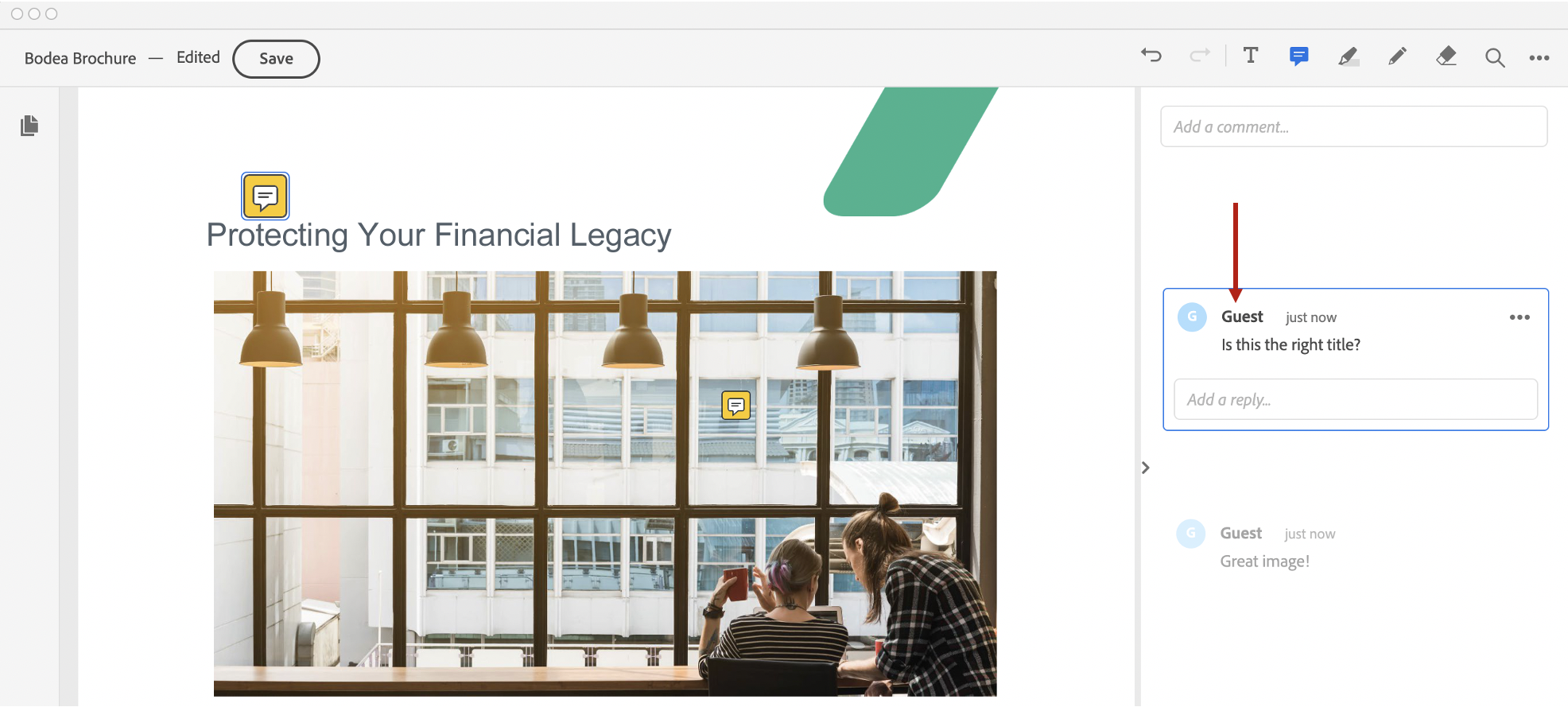
When the callback is registered, user annotations are associated with the corresponding username.
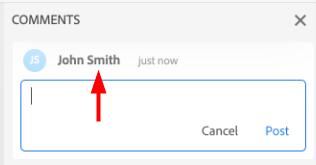
User profile callback signature
const profile = {
userProfile: {
name: <name of user>,
firstName: <first name>,
lastName: <last name>,
email: <user email>
}
};
adobeDCView.registerCallback(
AdobeDC.View.Enum.CallbackType.GET_USER_PROFILE_API,
function() {
return new Promise((resolve, reject) => {
resolve({
code: AdobeDC.View.Enum.ApiResponseCode.SUCCESS,
data: profile
});
});
},
{});
User settings¶
Users can update the colour of an annotation by clicking on the PDF annotation and changing the colour from the toolbar. The updated colour is applied to all new annotations of that type added to the PDF. Also, when any annotation tool is selected from the top bar for the first time, there is a coach mark displayed to educate users about the annotation tool which goes away after a few seconds.
Note
Previously, the default implementation of these user preferences was that the browser used to remember the updated annotation colour and also whether the coach mark for a selected annotation tool has been displayed or not. This was achieved by storing this data in the local storage of the PDF Embed API domain. This is now deprecated and PDF Embed API does not store this data.
By default, these preferences are lost when the PDF reloads. As a result, the updated annotation colour is not remembered (default annotation colour will be applied in this case) and users will see annotation tool coach marks again when the PDF reloads.
Website developers can improve this experience by registering the user setting callbacks. There are two callbacks involved:
SET_USER_SETTING_API: This callback saves user-specific settings.
GET_USER_SETTING_API: This callback fetches the current user setting.
Developers can provide their own implementation using these callbacks and save the user preferences wherever they like.
User settings callback signature
adobeDCView.registerCallback(
AdobeDC.View.Enum.CallbackType.SET_USER_SETTING_API,
function(setting) {
/* Add your custom implementation here to save the user setting */
...
...
return new Promise((resolve, reject) => {
resolve({
code: AdobeDC.View.Enum.ApiResponseCode.SUCCESS
});
});
},
{});
adobeDCView.registerCallback(
AdobeDC.View.Enum.CallbackType.GET_USER_SETTING_API,
function() {
/* Fetch the user setting */
return new Promise((resolve, reject) => {
resolve({
code: AdobeDC.View.Enum.ApiResponseCode.SUCCESS,
data: {
setting: <USER_STORED_SETTING>
}
});
});
},
{});
Find the working code sample here under /More Samples/Save User Preferences/.
In this code sample, the user setting callbacks are used to save the user preferences in the local storage of the website domain. Using this implementation, the browser remembers the updated annotation colour and also shows the coach mark only once for every annotation tool in the current browser.
This is only an example and it is up to the website developer how they do the actual implementation of saving the user preferences.
Save a PDF¶
The Save button on the top bar is not visible unless the PDF is modified: it only becomes active after PDF modification (there are changes to actually save). For example, when showAnnotationTools is true, users can add an annotation or comment, and you can provide them with the option to save the modified PDF to a local or networked location.
Note
A user cannot add comments or edit PDF files that are secure, protected, or read-only. The annotation tools as well as the save button are hidden for such files.
Note that while the Save button is hidden by default, you can show the button even when there are no changes to save by setting showDisabledSaveButton to true and passing it as a preview configuration to the previewFile API. In this case, the save button appears in disabled state until the PDF is modified.
{
showDisabledSaveButton: <Boolean, default=false>,
}
Save callback¶
This callback allows users to save the updated PDF buffer which can then be stored in an external file storage system.
If you do not register a callback, when a user triggers the save functionality, the app downloads the updated PDF to the user’s local machine. The default location is often the Downloads folder.
If you do register a callback, then your code can enable saving the modified document to an external file storage system like OneDrive or Google Drive. In this case, the code varies with the website developer’s implementation.
Users can trigger the save functionality by either clicking on the Save button manually or by pressing Ctrl+S on the keyboard. You should register the callback to receive the modified file content when the user initiates the save.
To control the save callback behavior, you can pass the following options:
autoSaveFrequency: Optional. Default value is 0. The save callback supports auto-saving so that manual saving is not required. The value is the time in seconds after which the PDF is auto-saved if there are any unsaved changes and no other annotation changes are made in the meantime. Using this configuration, the document is saved even if the user does not manually save. You must set this parameter to a numeric value greater than 0.enableFocusPolling: Optional. Default value is false. When true, a PDF with unsaved changes is auto-saved whenever the user focus shifts from the current PDF preview (for example, by opening a new tab in the same browser). When false, auto-save does not happen. Set this parameter to true if you want this to work.showSaveButton: Optional. Default value is true. Set this to false if you don’t want the save button to be displayed at all, not even when the PDF is modified. When set to false, the save button is never displayed and save operation will be done through auto-save or through the keyboard by pressing Ctrl+S.
The second callback parameter is a Javascript function returning a Promise which either resolves or fails with a response object containing code and data. The function parameters include:
metaData: Information about the filecontent: The ArrayBuffer of file contentoptions: (optional) Additional user options passed to the function to control its behavior in certain cases. For instance, thesaveAsoption is passed here when the current user saves a copy of a changed PDF when multiple users are modifying the same file (See the FILE_MODIFIED case below).
Save callback signature
const saveOptions = {
autoSaveFrequency: <Number, default=0>,
enableFocusPolling: <Boolean, default=false>,
showSaveButton: <Boolean, default=true>
}
adobeDCView.registerCallback(
AdobeDC.View.Enum.CallbackType.SAVE_API,
function(metaData, content, options) {
/* Add your custom save implementation here...and based on that resolve or reject response in given format */
return new Promise((resolve, reject) => {
resolve({
code: AdobeDC.View.Enum.ApiResponseCode.SUCCESS,
data: {
/* Updated file metadata after successful save operation */
metaData: <File MetaData>
}
});
});
},
saveOptions
);
The website developer can write their own save implementation in this function and should send the response object with the appropriate code and data in the following format:
SUCCESS: Use this response code to denote a successful save operation where the response data contains the updated file metadata.
FAIL: Use the FAIL response code when the save API fails. Response data is optional in this case. The user will see an error popup and should retry saving.

FILE_MODIFIED
Use the response code FILE_MODIFIED to capture the case when two users simultaneously modify a single PDF. This case only occurs for shared files. The save functionality will fail for the current user if the file content has been previously modified by another user. The response data will contain the name and email of the other user modifying the same file.
In this scenario, the current user sees a popup with two options:
Save a copy: Choosing the Save a copy button initiates the save callback again and saves a copy of the PDF with the current user’s changes. The
{saveAs: true}option is passed to theoptionsparameter of the function to denote that a new PDF is saved.Discard my changes: Discards the current user’s changes and reloads the PDF.
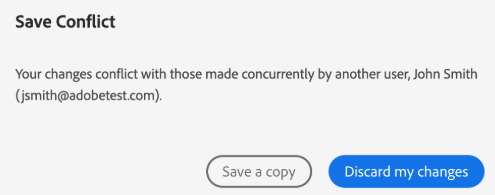
Save callback
/* Options to control save behavior */
const saveOptions = {
autoSaveFrequency: <Number, default=0>,
enableFocusPolling: <Boolean, default=false>,
showSaveButton: <Boolean, default=true>
}
/* Register save callback */
adobeDCView.registerCallback(
AdobeDC.View.Enum.CallbackType.SAVE_API,
function(metaData, content, options) {
/* Write down your own save implementation here... and based on that resolve or reject response in given format */
/* Save callback success case */
return new Promise((resolve, reject) => {
resolve({
code: AdobeDC.View.Enum.ApiResponseCode.SUCCESS,
data: {
metaData: Object.assign(metaData, {fileName: <UPDATED_FILE_NAME>})
}
});
});
/* Save callback failure case */
/* return new Promise((resolve, reject) => {
reject({
code: AdobeDC.View.Enum.ApiResponseCode.FAIL,
data: {
<Optional>
}
});
}); */
/* Save callback file modified case */
/* return new Promise((resolve, reject) => {
resolve({
code: AdobeDC.View.Enum.ApiResponseCode.FILE_MODIFIED,
data: {
modifiedBy: {
name: <Username of the user who modified the file>,
mail: <Email of the user who modified the file>,
}
}
});
}); */
},
saveOptions);
Status callback¶
The status callback allows you to poll the status of the file to check whether the currently open file is changed by another user or not. This file status polling occurs after a fixed interval of time defined in the filePollFrequency option. Use both the save and status callbacks together to achieve the complete save experience including auto-save and file status polling.
Note
While you can specify additional options to control the status callback, both autoSaveFrequency and enableFocusPolling are deprecated for the status callback. Developers are advised to use these options with the save callback.
filePollFrequency: Optional. Default value is 10 seconds. The time in seconds after which the file is polled for changes. To disable file status polling, setfilePollFrequencyto 0. By default, file status polling starts when there are unsaved changes made in the PDF by the current user.keepPolling: Optional. Default value is false (boolean). SetkeepPollingto true if you want file status polling to work continuously even if there are no unsaved changes made to the file by the current user. The frequency of the file status polling is governed by the time specified infilePollFrequency.
Status callback signature
const statusOptions = {
filePollFrequency: <Number, default=10>,
keepPolling: <Boolean, default=false>
};
adobeDCView.registerCallback(
AdobeDC.View.Enum.CallbackType.STATUS_API,
function(metaData) {
/* Resolve or reject response in given format */
return new Promise((resolve, reject) => {
resolve({
code: AdobeDC.View.Enum.ApiResponseCode.SUCCESS,
data: {
<Optional>
}
});
});
},
statusOptions
);
The second parameter of the callback is a Javascript function returning a Promise which either resolves or fails with a response object containing a code and data. metaData is the only function parameter, and it refers to the file information. The response code in the Promise can take either SUCCESS or FILE_MODIFIED:
SUCCESS: Use the response code SUCCESS to denote successful file polling and that the file has no changes made by another user. Response data is optional here.
FILE_MODIFIED: Use the response code FILE_MODIFIED to capture the case of conflicting updates made by another user in a file sharing scenario. Response data will contain the name and email of the other user modifying the same file. Note the following:
If the Promise returns FILE_MODIFIED when the current user has not changed the file, that denotes that the file was already modified by another user and the current user is viewing an old version of the file. The user sees a popup with the “Get Latest Version” option which will reload the latest version of the file.
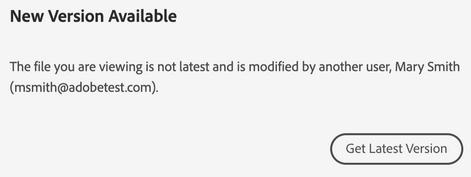
If the Promise returns FILE_MODIFIED after the current user has changed the file, that denotes that two users are modifying the same file simultaneously. In this scenario, the current user sees a popup with two options: Save a copy saves a copy of the PDF with the current user’s changes while Discard my changes discards the current user’s changes and reloads the PDF.
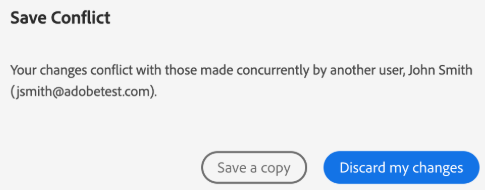
Status callback
const statusOptions = {
filePollFrequency: <Number, default=10>,
keepPolling: <Boolean, default=false>
};
adobeDCView.registerCallback(
AdobeDC.View.Enum.CallbackType.STATUS_API,
function(metaData) {
/* Resolve or reject response in given format */
/* Status callback success case */
return new Promise((resolve, reject) => {
resolve({
code: AdobeDC.View.Enum.ApiResponseCode.SUCCESS,
});
});
/* Status callback file modified case */
/* return new Promise((resolve, reject) => {
resolve({
code: AdobeDC.View.Enum.ApiResponseCode.FILE_MODIFIED,
data: {
modifiedBy: {
name: <Username of the user who modified the file>,
mail: <Email of the user who modified the file>,
}
}
});
}); */
},
statusOptions
);
Forms handling¶
The PDF Embed API supports live form editing by default. End users can add and edit text in text fields and interact with other form objects, including radio buttons, check boxes, lists, and drop downs (select lists). When users fill any form field, the Save button in the top menu is automatically enabled so that they can save their information to the PDF. The PDF Embed API renders forms so that they appear similar to forms viewed in the full Acrobat app:

Note
Form editing capability is supported only in Full Window embed mode.
Control form editing capability by simply toggling enableFormFilling on and off as needed. While the Embed API enables form editing by default, you can disable the feature by setting it to false.
<div id="adobe-dc-view"></div>
<script src="https://documentcloud.adobe.com/view-sdk/main.js"></script>
<script type="text/javascript">
document.addEventListener("adobe_dc_view_sdk.ready", function () {
var adobeDCView = new AdobeDC.View({clientId: "<YOUR_CLIENT_ID>", divId: "adobe-dc-view"});
adobeDCView.previewFile({
content:{location: {url: "https://documentcloud.adobe.com/view-sdk-demo/PDFs/Bodea Brochure.pdf"}},
metaData:{fileName: "Bodea Brochure.pdf"}
}, {enableFormFilling: false, dockPageControls: false});
});
</script>
Disabling form editing un-highlights form fields:

Unsupported form fields¶
In the current version, following form fields are unsupported:
XFA forms
Digital Signature fields.
Barcode fields.
File picker text field
RTF (rich text) text field
Fields containing JavaScript or any kind of calculation and validation
Text field and drop downs with some special and custom formats
PDF Actions that includes button Submit scenarios (only button viewing is supported)
When the API detects unsuppported form fields, a dialog appears on the rendered PDF:

Viewer API¶
The PDF Embed API provides a number of viewer APIs for customizing the user interface and user interactions with the PDF. These APIs can be used to perform UI customizations programmatically at run-time.
GetAPIs Interface¶
The getAPIs interface allows you to invoke any of the viewer APIs as follows:
1 <html>
2 <head>
3 <title>Adobe Document Services PDF Embed API Sample</title>
4 <meta charset="utf-8"/>
5 <meta http-equiv="X-UA-Compatible" content="IE=edge,chrome=1"/>
6 <meta id="viewport" name="viewport" content="width=device-width, initial-scale=1"/>
7 </head>
8 <body style="margin: 0px">
9 <div id="adobe-dc-view"></div>
10 <script src="https://documentcloud.adobe.com/view-sdk/main.js"></script>
11 <script type="text/javascript">
12 document.addEventListener("adobe_dc_view_sdk.ready", function()
13 {
14 var adobeDCView = new AdobeDC.View({clientId: "<YOUR_CLIENT_ID>", divId: "adobe-dc-view"});
15 var previewFilePromise = adobeDCView.previewFile({
16 content: {location: {url: "https://documentcloud.adobe.com/view-sdk-demo/PDFs/Bodea Brochure.pdf"}},
17 metaData: {fileName: "Bodea Brochure.pdf"}
18 });
19
20 previewFilePromise.then(adobeViewer => {
21 adobeViewer.getAPIs().then(apis => {
22 // All viewer APIs can be invoked here
23 });
24 });
25 });
26 </script>
27 </body>
28 </html>
Zoom APIs¶
These APIs can be used to perform zoom operations on the PDF programmatically. These APIs are supported in all embed modes except in-line embed mode.
getZoomLimits¶
This API returns the minimum and maximum allowed zoom levels of the PDF.
Input parameters |
N/A |
API output |
Returns a Promise which,
|
API signature |
previewFilePromise.then(adobeViewer => {
adobeViewer.getAPIs().then(apis => {
apis.getZoomAPIs().getZoomLimits()
.then(result => console.log(result))
.catch(error => console.log(error));
});
});
|
zoomIn¶
This API zooms in on the PDF and magnifies the PDF view to the next zoom level. The magnified zoom level will never exceed the maximum zoom level of the PDF.
Input parameters |
N/A |
API output |
Returns a Promise which,
|
API signature |
previewFilePromise.then(adobeViewer => {
adobeViewer.getAPIs().then(apis => {
apis.getZoomAPIs().zoomIn()
.then(result => console.log(result))
.catch(error => console.log(error));
});
});
|
zoomOut¶
This API zooms out of the PDF and reduces the PDF view to the previous zoom level. The reduced zoom level will never be less than the minimum zoom level of the PDF.
Input parameters |
N/A |
API output |
Returns a Promise which,
|
API signature |
previewFilePromise.then(adobeViewer => {
adobeViewer.getAPIs().then(apis => {
apis.getZoomAPIs().zoomOut()
.then(result => console.log(result))
.catch(error => console.log(error));
});
});
|
setZoomLevel¶
This API accepts a float value as input and sets the zoom level of the PDF to that value. The input must lie between the minimum and maximum allowed zoom levels of the PDF.
If the input passed is less than the minimum zoom level, then the minimum zoom level is applied to the PDF. Similarly, if the input passed is greater than the maximum zoom level, then the maximum zoom level is applied.
Input parameters |
<ZOOM_LEVEL: Float> |
API output |
Returns a Promise which,
|
API signature |
previewFilePromise.then(adobeViewer => {
adobeViewer.getAPIs().then(apis => {
apis.getZoomAPIs().setZoomLevel(<ZOOM_LEVEL>)
.then(result => console.log(result))
.catch(error => console.log(error));
});
});
|
Search APIs¶
This API can be used to search for a term in the PDF programmatically. This API is supported in all embed modes.
In order to enable search APIs, the configuration variable enableSearchAPIs should be set to true and passed as a preview configuration to the previewFile API.
1 <html>
2 <head>
3 <title>Adobe Document Services PDF Embed API Sample</title>
4 <meta charset="utf-8"/>
5 <meta http-equiv="X-UA-Compatible" content="IE=edge,chrome=1"/>
6 <meta id="viewport" name="viewport" content="width=device-width, initial-scale=1"/>
7 </head>
8 <body style="margin: 0px">
9 <div id="adobe-dc-view"></div>
10 <script src="https://documentcloud.adobe.com/view-sdk/main.js"></script>
11 <script type="text/javascript">
12 document.addEventListener("adobe_dc_view_sdk.ready", function()
13 {
14 var adobeDCView = new AdobeDC.View({clientId: "<YOUR_CLIENT_ID>", divId: "adobe-dc-view"});
15 var previewFilePromise = adobeDCView.previewFile({
16 content: {location: {url: "https://documentcloud.adobe.com/view-sdk-demo/PDFs/Bodea Brochure.pdf"}},
17 metaData: {fileName: "Bodea Brochure.pdf"}
18 }, { enableSearchAPIs: true });
19
20 previewFilePromise.then(adobeViewer => {
21 adobeViewer.getAPIs().then(apis => {
22 // All viewer APIs can be invoked here
23 });
24 });
25 });
26 </script>
27 </body>
28 </html>
Note
The document search option is not available in UI when search APIs are enabled.
The search API takes a search term of String value as input and searches for that term in the entire document. The first occurrence of the search term is highlighted in the PDF, starting from the current page in view.
Input parameters |
<SEARCH_STRING: String> |
API output |
Returns a Promise which,
|
API signature |
previewFilePromise.then(adobeViewer => {
adobeViewer.getAPIs().then(apis => {
apis.search(<SEARCH_STRING>)
.then(searchObject => console.log(searchObject))
.catch(error => console.log(error));
});
});
|
onResultsUpdate¶
Users can register a callback function and pass as an input to the onResultsUpdate() function. This callback function will be triggered every time a search operation takes place through the search API and the search result is highlighted in the PDF. The callback function will receive important information about the current search result in the form of a JSON. The JSON will include information such as, current page number, current search result index, total number of search results and status.
{
currentResult: {
pageNumber: Integer, // Current page number in view
index: Integer, // Index of the current highlighted search result
},
totalResults: Integer, // Total number of search results found till the time callback function is executed
status: String // Status of search result till the time callback function is executed. Values can be "IN_PROGRESS" or "COMPLETED".
}
Input parameters |
N/A |
API output |
Returns a Promise which,
|
API signature |
function callbackFunction(searchResult) {
console.log("Current search result: ", searchResult);
}
previewFilePromise.then(adobeViewer => {
adobeViewer.getAPIs().then(apis => {
apis.search(<SEARCH_STRING>).then(searchObject => {
searchObject.onResultsUpdate(callbackFunction)
.then(result => console.log(result))
.catch(error => console.log(error));
})
.catch(error => console.log(error));
});
});
|
next¶
This function will highlight and navigate to the next search result in the PDF.
Input parameters |
N/A |
API output |
Returns a Promise which,
|
API signature |
previewFilePromise.then(adobeViewer => {
adobeViewer.getAPIs().then(apis => {
apis.search(<SEARCH_STRING>).then(searchObject => {
searchObject.next()
.then(result => console.log(result))
.catch(error => console.log(error));
})
.catch(error => console.log(error));
});
});
|
previous¶
This function will highlight and navigate to the previous search result in the PDF.
Input parameters |
N/A |
API output |
Returns a Promise which,
|
API signature |
previewFilePromise.then(adobeViewer => {
adobeViewer.getAPIs().then(apis => {
apis.search(<SEARCH_STRING>).then(searchObject => {
searchObject.previous()
.then(result => console.log(result))
.catch(error => console.log(error));
})
.catch(error => console.log(error));
});
});
|
clear¶
This function will cancel the ongoing search operation and clear the search results.
Input parameters |
N/A |
API output |
Returns a Promise which,
|
API signature |
previewFilePromise.then(adobeViewer => {
adobeViewer.getAPIs().then(apis => {
apis.search(<SEARCH_STRING>).then(searchObject => {
searchObject.clear()
.then(result => console.log(result))
.catch(error => console.log(error));
})
.catch(error => console.log(error));
});
});
|
Note
Find the working code sample for search and zoom APIs here under /More Samples/Viewer APIs/Search and Zoom APIs
Bookmark APIs¶
These APIs programmatically access existing PDF bookmarks. Note that only the Full Window embed mode supports these APIs.
getBookmarks¶
This API returns the list of existing PDF bookmarks Each bookmark item in this list is represented as a JSON containing important information such as, ID, title and the list of nested bookmarks residing under this bookmark.
{
id: Number // Unique identifier of the bookmark
title: String, // Title of the bookmark
children: [ CHILD_BOOKMARK_1, CHILD_BOOKMARK_2, ... ] // List of nested bookmarks which exists under this bookmark
}
Input parameters |
N/A |
API output |
Returns a Promise which,
|
API signature |
previewFilePromise.then(adobeViewer => {
adobeViewer.getAPIs().then(apis => {
apis.getBookmarkAPIs().getBookmarks()
.then(result => console.log(result))
.catch(error => console.log(error));
});
});
|
openBookmark¶
This API accepts a bookmark ID as input and navigates to that particular PDF bookmark.
Input parameters |
<BOOKMARK_ID> |
API output |
Returns a Promise which,
|
API signature |
const bookmark_ID = <BOOKMARK_ID>;
previewFilePromise.then(adobeViewer => {
adobeViewer.getAPIs().then(apis => {
apis.getBookmarkAPIs().openBookmark(bookmark_ID)
.then(result => console.log(result))
.catch(error => console.log(error));
});
});
|
Note
Find the working code sample here under /More Samples/Viewer APIs/Bookmark APIs
Attachment APIs¶
These APIs access the existing attachments in the PDF programmatically.
getAttachments¶
This API returns the list of existing attachments in the PDF. Each attachment item in this list is represented as a JSON containing important information such as, name, mime type, description, creation date and modified date.
{
name: String // Name of the attachment file
description: String, // Description of the attachment
mimeType: String // Mime type of the attachment file
created: Date // Date when the attachment was created
modified: Date // Date when the attachment was modified
}
Input parameters |
N/A |
API output |
Returns a Promise which,
|
API signature |
previewFilePromise.then(adobeViewer => {
adobeViewer.getAPIs().then(apis => {
apis.getAttachmentAPIs().getAttachments()
.then(result => console.log(result))
.catch(error => console.log(error));
});
});
|
getAttachmentBuffer¶
This API accepts the name of an attachment as input and returns the ArrayBuffer of the attachment content.
Input parameters |
<ATTACHMENT_NAME: String> |
API output |
Returns a Promise which,
|
API signature |
previewFilePromise.then(adobeViewer => {
adobeViewer.getAPIs().then(apis => {
apis.getAttachmentAPIs().getAttachmentBuffer(<ATTACHMENT_NAME>)
.then(result => console.log(result))
.catch(error => console.log(error));
});
});
|
Note
Find the working code sample here under /More Samples/Viewer APIs/Attachment APIs
Other APIs¶
getPDFMetadata¶
This API returns basic information about the PDF fetched from the PDF dictionary; for example, the PDF’s number of pages and title.
Input parameters |
N/A |
API output |
Returns a Promise which,
|
API signature |
previewFilePromise.then(adobeViewer => {
adobeViewer.getAPIs().then(apis => {
apis.getPDFMetadata()
.then(result => console.log(result))
.catch(error => console.log(error));
});
});
|
getXMPMetadata¶
XMP (Extensible Metadata Platform) is a technology developed by Adobe which provides a common XML framework to store metadata in digital documents. XMP Metadata includes information about the document and its contents, such as the author’s name, keywords, and copyright information.
getXMPMetadata checks the PDF for XMP metadata and returns it if present. The API accepts two optional input parameters.
The first optional input parameter takes a list of XMP metadata fields. The API returns the values of only these fields. If no field is passed, then it returns the default field values.
The second optional input parameter takes a boolean value. If true, the API will also return the complete XMP metadata stream. The default value is false.
Input parameters |
|
API output |
Returns a Promise which,
|
API signature |
const fields = ["dc:title", "dc:creator", "xmp:CreateDate"];
const includeRawStream = true;
previewFilePromise.then(adobeViewer => {
adobeViewer.getAPIs().then(apis => {
apis.getXMPMetadata(fields, includeRawStream)
.then(result => console.log(result))
.catch(error => console.log(error));
});
});
|
getSelectedContent¶
If a user selects any content in the viewer, then the selected content can be fetched using this API. This API currently only works with text selection.
Input parameters |
N/A |
API output |
Returns a Promise which,
|
API signature |
previewFilePromise.then(adobeViewer => {
adobeViewer.getAPIs().then(apis => {
apis.getSelectedContent()
.then(result => console.log(result))
.catch(error => console.log(error));
});
});
|
setCursor¶
This API sets the page cursor to any cursor style, such as help, wait, crosshair, etc.
Input parameters |
A string denoting the cursor style: <Cursor_Type> |
API output |
N/A |
API signature |
const cursor_type = <Cursor_Type>;
previewFilePromise.then(adobeViewer => {
adobeViewer.getAPIs().then(apis => {
apis.setCursor(cursor_type)
.then(() => console.log("Success"))
.catch(error => console.log(error));
});
});
|
resetCursor¶
This API revokes an applied cursor style and reverts it to the default cursor style.
Input parameters |
N/A |
API output |
N/A |
API signature |
previewFilePromise.then(adobeViewer => {
adobeViewer.getAPIs().then(apis => {
apis.resetCursor();
});
});
|
getCurrentPage¶
This API returns the current page number of the in focus page.
Input parameters |
N/A |
API output |
Returns a Promise which,
|
API signature |
previewFilePromise.then(adobeViewer => {
adobeViewer.getAPIs().then(apis => {
apis.getCurrentPage()
.then(result => console.log(result))
.catch(error => console.log(error));
});
});
|
getPageZoom¶
This API takes the PDF page number as input and returns the zoom level of that page.
Input parameters |
<Page_Number> |
API output |
Returns a Promise which,
|
API signature |
previewFilePromise.then(adobeViewer => {
adobeViewer.getAPIs().then(apis => {
apis.getPageZoom(<Page_Number>)
.then(result => console.log(result))
.catch(error => console.log(error));
});
});
|
gotoLocation¶
This API enables navigation to any PDF page. It accepts a page number as input. You can also pass the x and y coordinates on the page as optional input parameters to enable navigation to a particular location on the page. When no coordinates are passed, the default coordinates are (0, 0).
Note
Navigation will not work if the specified page number exceeds the PDF page limit. Moreover, the x and y input coordinates must be within the PDF page width and height limit. If either the x or y coordinate is not within the page limit, then they default to 0.
Input parameters |
(<Page_Number>, <X_Coordinate>, <Y_Coordinate>) |
API output |
Returns a Promise which,
|
API signature |
previewFilePromise.then(adobeViewer => {
adobeViewer.getAPIs().then(apis => {
apis.gotoLocation(<Page_Number>, <X_Coordinate>, <Y_Coordinate>)
.then(() => console.log("Success"))
.catch(error => console.log(error));
});
});
|
clearPageSelection¶
This API accepts a page number as input and clears any text selection applied to the page.
Input parameters |
<Page_Number> |
API output |
Returns a Promise which,
|
API signature |
previewFilePromise.then(adobeViewer => {
adobeViewer.getAPIs().then(apis => {
apis.clearPageSelection(pageNumber)
.then(() => console.log("Success"))
.catch(error => console.log(error));
});
});
|
enableTextSelection¶
This API controls text selection in PDF. The default is enabled (true). Note that disabling text selection also disables the highlight option in the top toolbar.
Input parameters |
Boolean |
API output |
Returns a Promise which,
|
API signature |
const allowTextSelection = false;
previewFilePromise.then(adobeViewer => {
adobeViewer.getAPIs().then(apis => {
apis.enableTextSelection(allowTextSelection)
.then(() => console.log("Success"))
.catch(error => console.log(error));
});
});
|